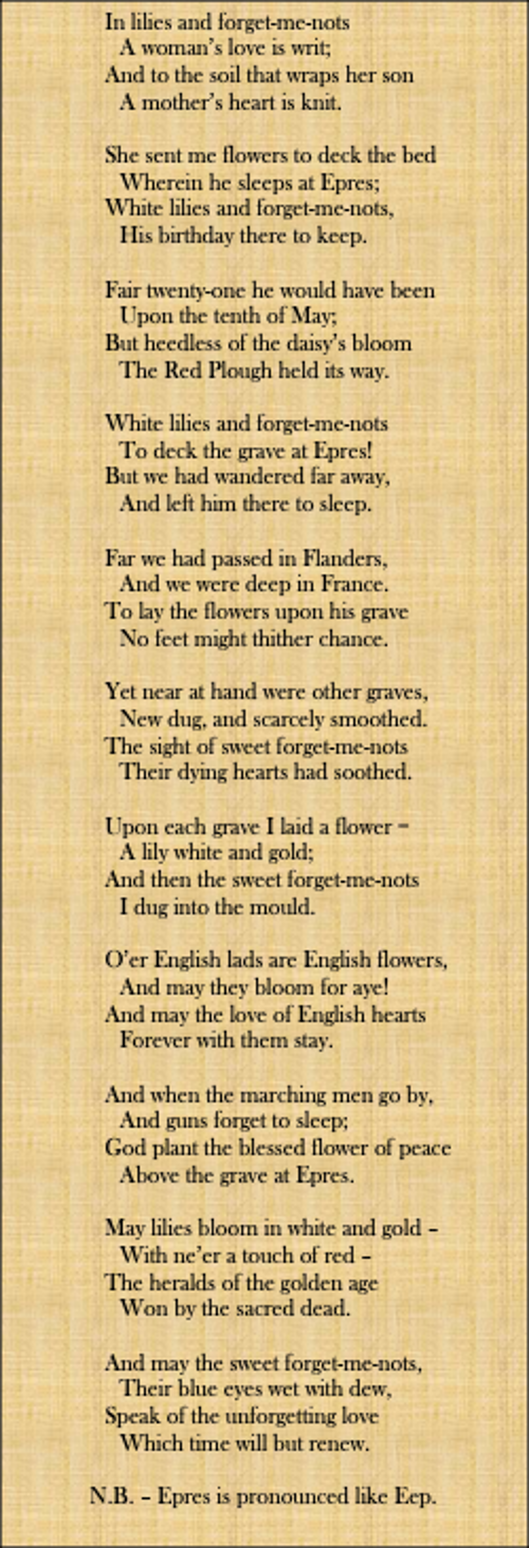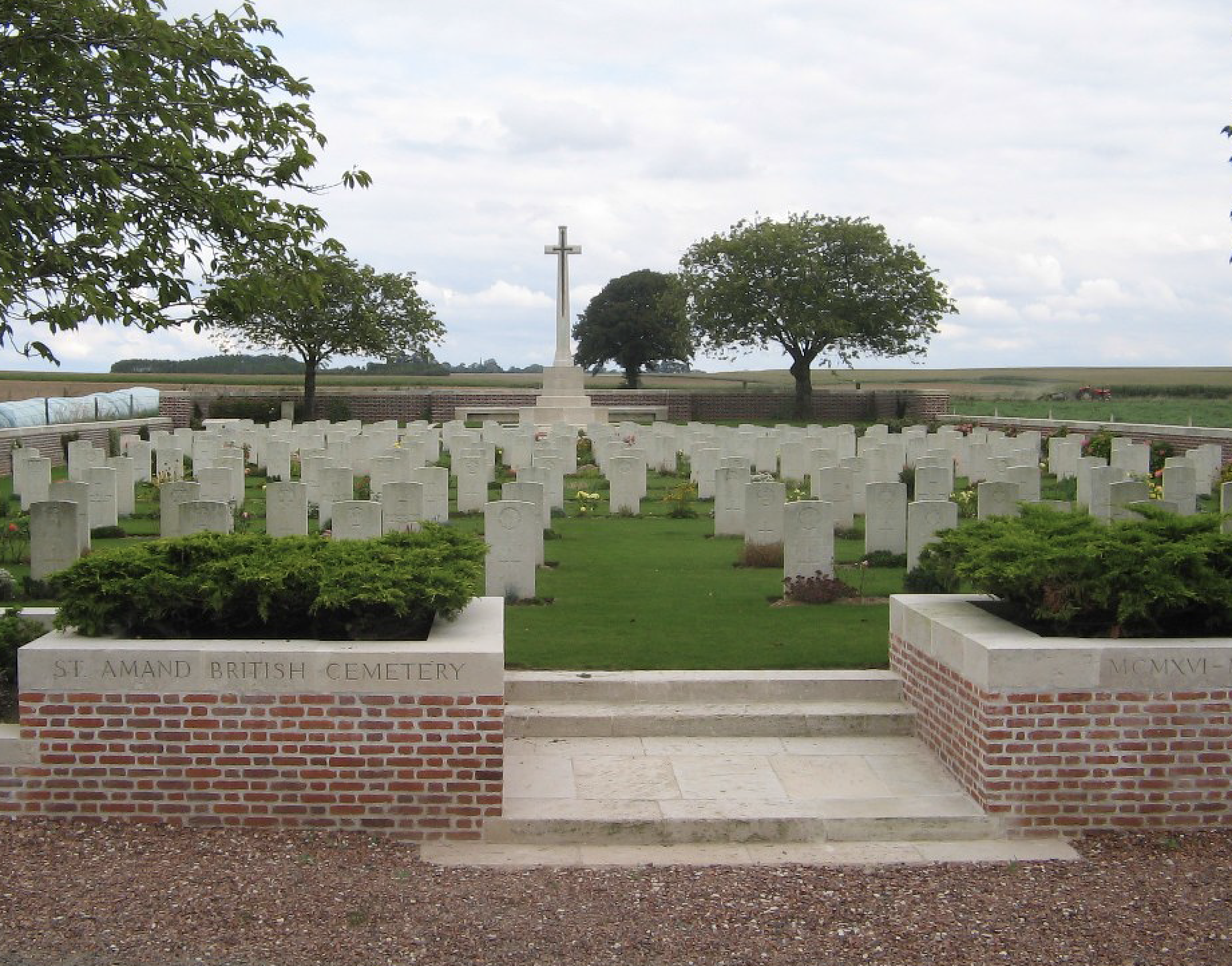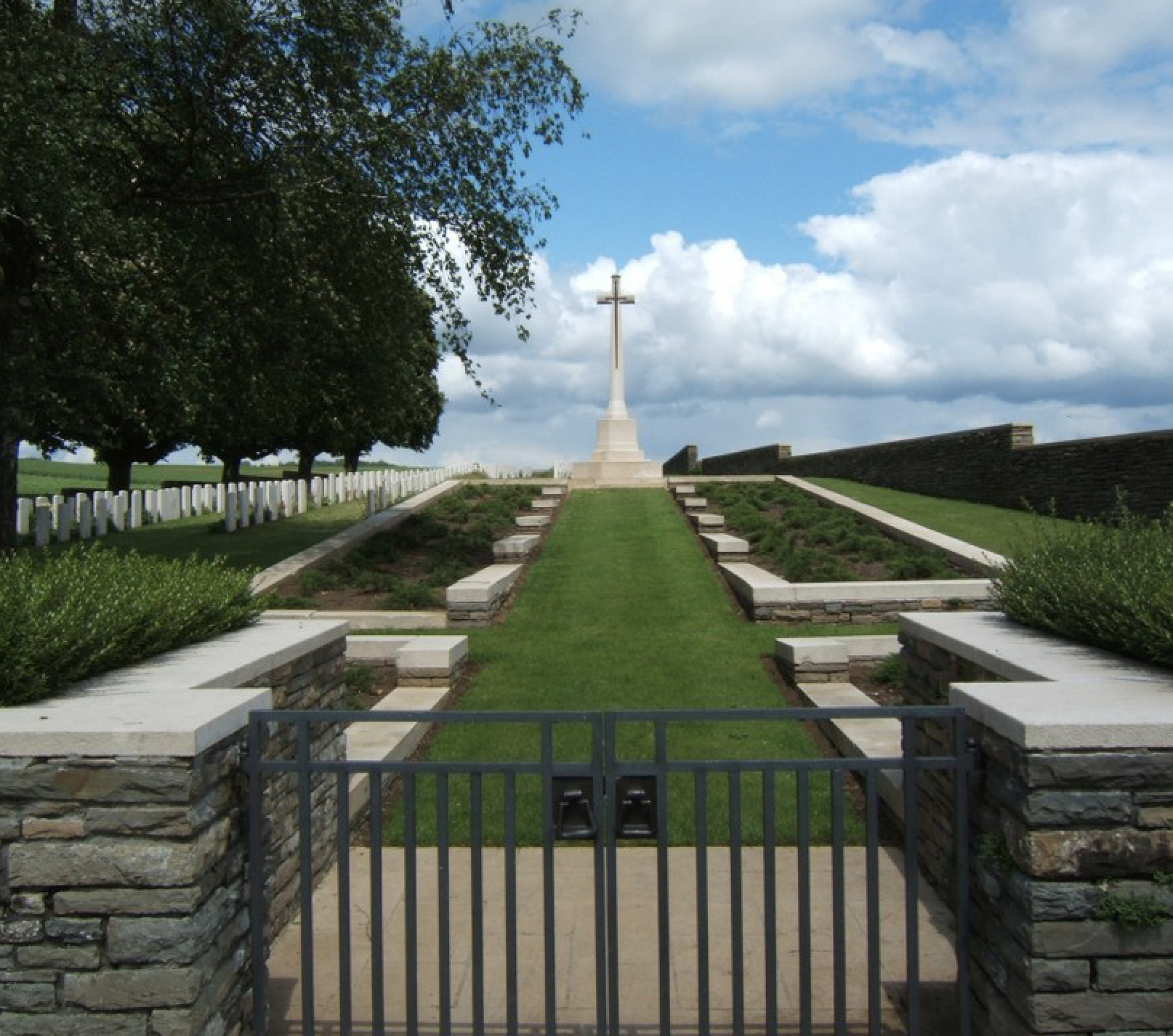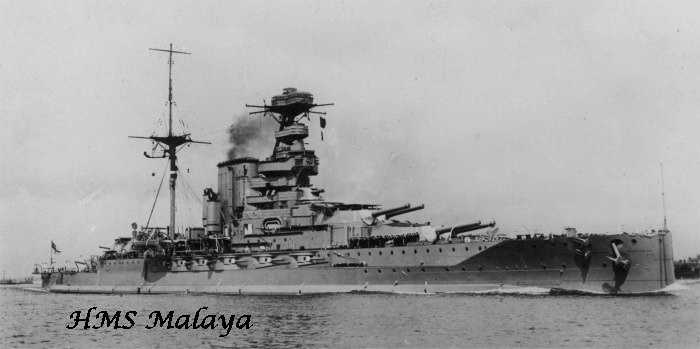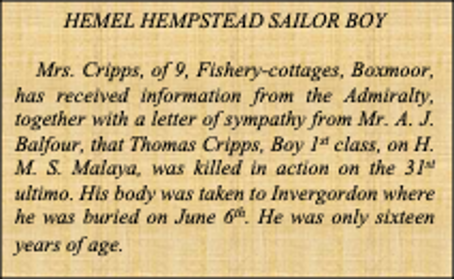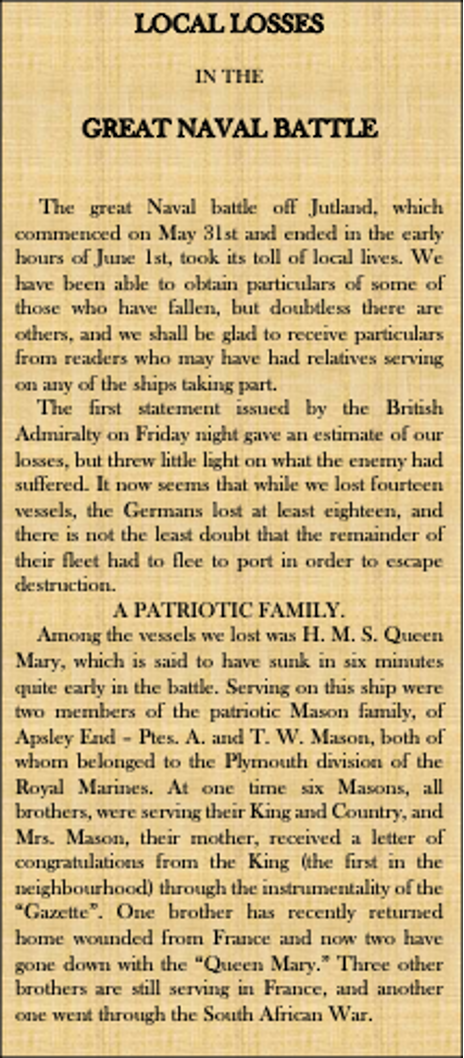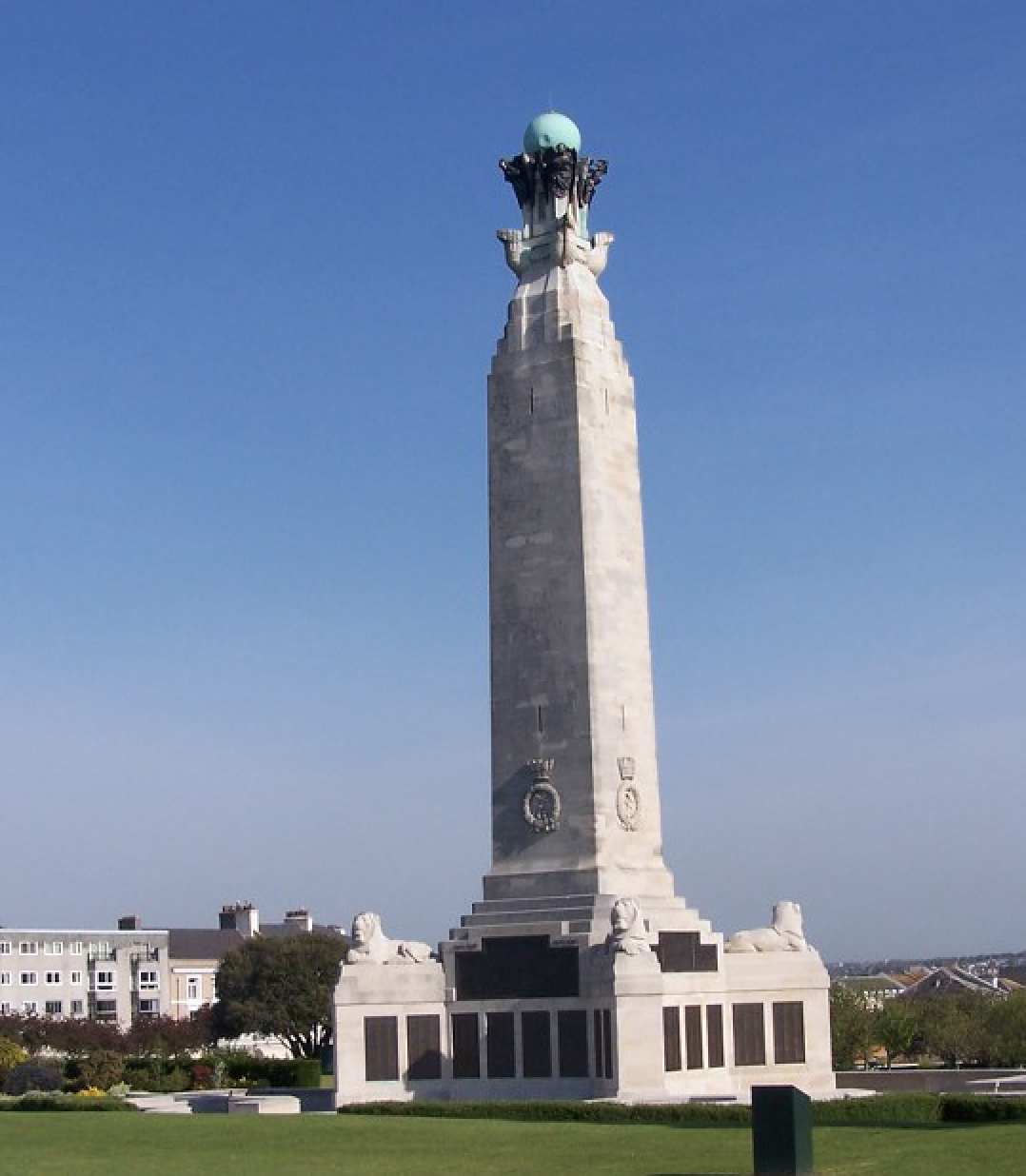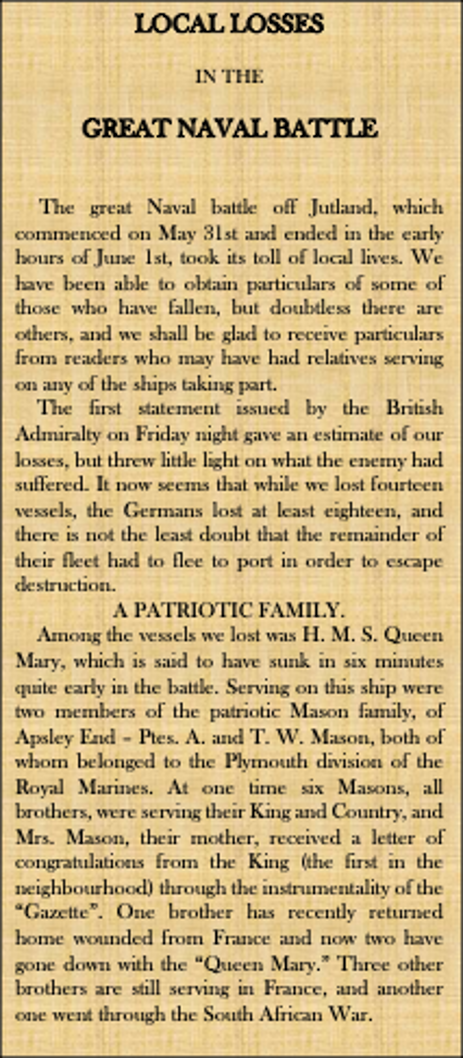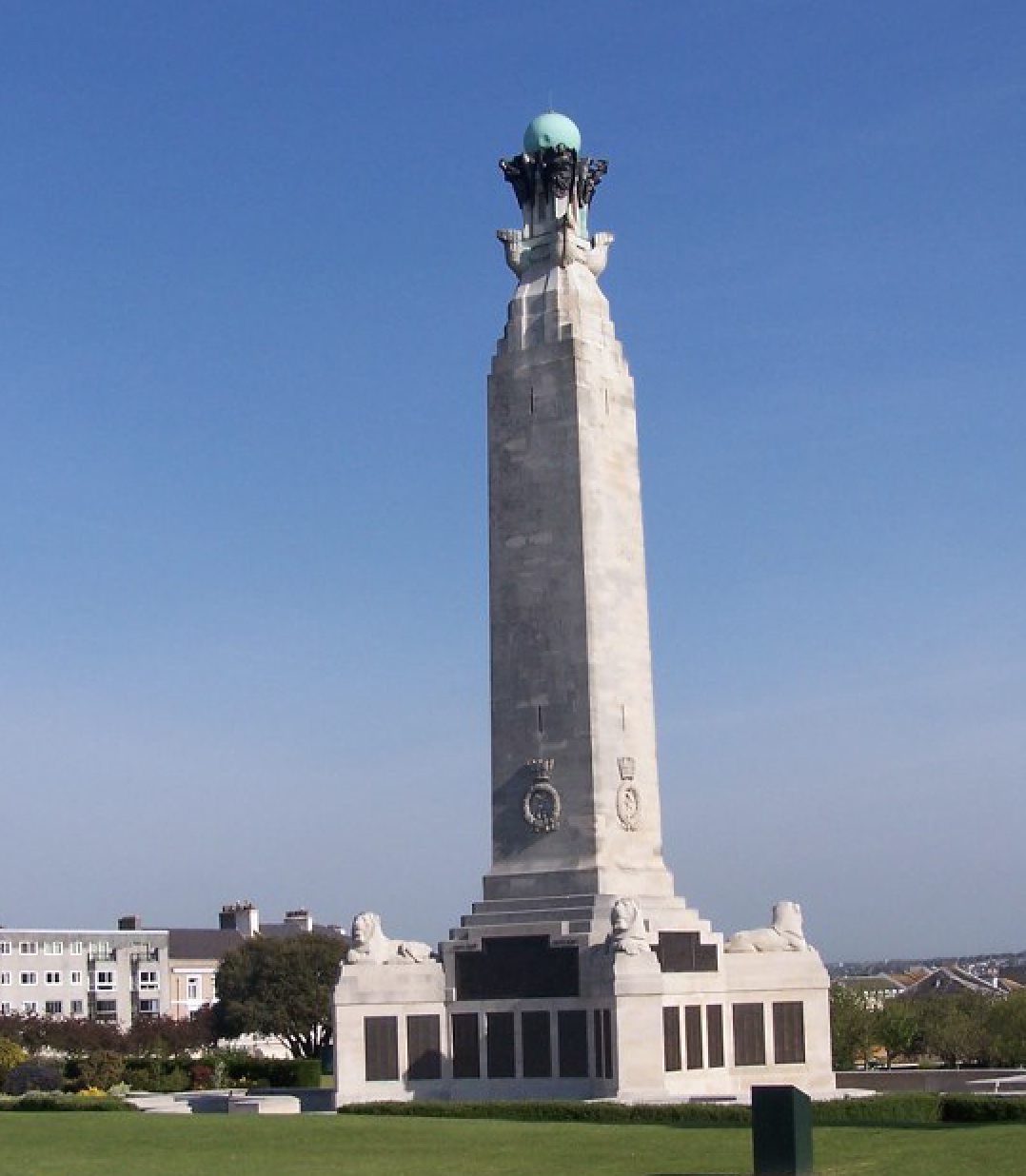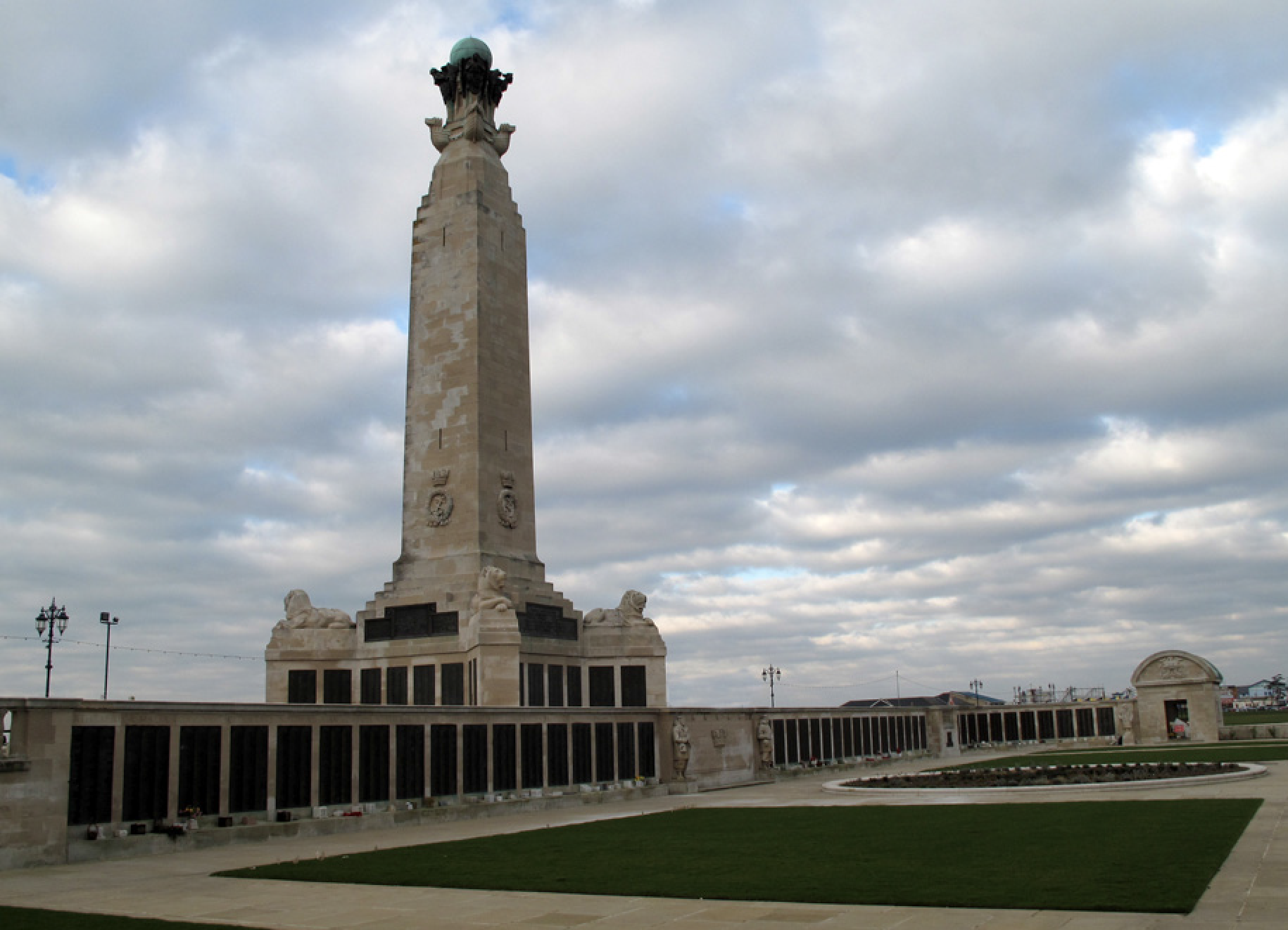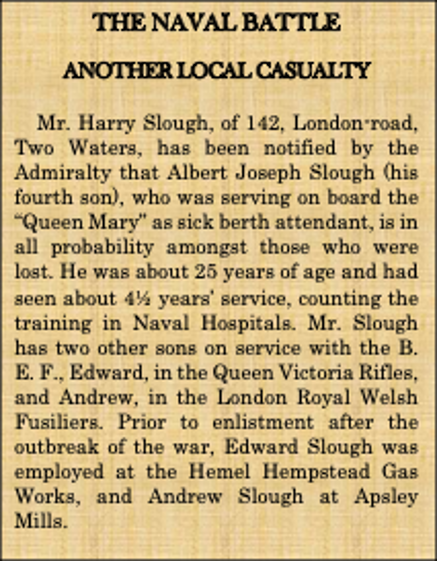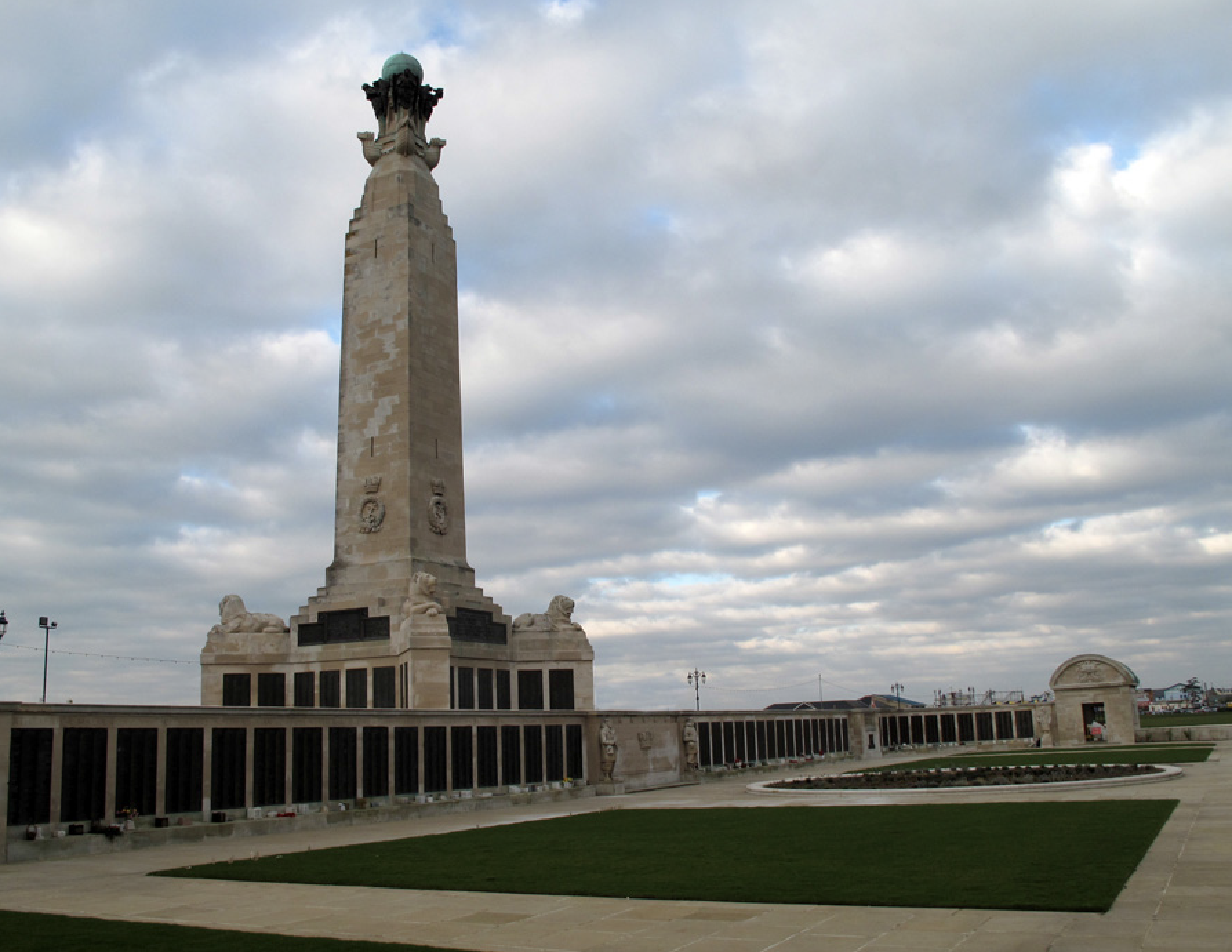Fallen in May 1916:
Charles William Hobbs
Alfred Smith
Frederick Townsend
Harry George Biswell
Frederick Charles Bladon
William Charles Plummer
Thomas Cripps
Alexander Mason
Thomas William Mason
Walter Leslie Monk
Albert Joseph Slough
James Wells
CHARLES WILLIAM HOBBS
20700 Private
8th Bn., Bedfordshire Regiment
Died of Wounds Thursday, 4th May 1916
Remembered with Honour, Lijssenthoek Military Cemetery, West-Vlaanderen, Belgium, Grave VI.C.28
Charles William Hobbs, known as Willie to his family, was born in Boxmoor, Hertfordshire on Monday, 8th April 1895 to Charles Hobbs and Ada Perry. He was baptised on Wednesday, 15th May in the same year at St John’s Parish Church in Boxmoor. Willie was the oldest of five children born to Charles and Ada and his siblings who lived were: Henry, Mabel and John. A fifth child died although research has not been able to verify a name.
The family lived at 27 Anchor Lane, Crouchfield in Boxmoor and Willie’s father Charles worked as a "Carmans [sic] Carter", though this may in fact have been two jobs. At the start of the 20th century a "Carmen" was often employed by railway companies for local deliveries and collections of goods and parcels similar to a modern-day van driver. A Carter typically drove a light two wheeled carriage and it seems Charles did both. Willie’s Grandmother Elizabeth and his Aunt Emma also lived with the family at this time.
Willie went to Boxmoor JMI School starting in the Infants department aged five in 1900 before joining the Middle school in February 1902. He completed Standards I and II before he left the school just after his thirteenth birthday in April 1908 when he started work helping his father as a Carter.
Three years
later in 1911 Willie and his brother Harry had found work with Dickinson and
Co. Ltd, both employed as ‘General Labourers’ at Apsley Mills. Willie remained
with Dickinsons on the outbreak of war, only leaving when he received his
employer’s permission to enlist in 1915. Dickinsons sought to strike a balance
between allowing men to enlist but ensuring that the business could continue to
operate, so any man wishing to join the colours had to first consult with their
Departmental Foreman. All who enlisted benefitted from a guaranteed job when
they returned and the payment of a proportion of their wages whilst in the
Forces. (see extract)
When Willie did enlist, he did so at Bedford in June or July of 1916 and was posted to the 8th Battalion Bedfordshire Regiment. He immediately went to Woking in Surrey for basic training and remained there for the rest of 1915. It is not known when Willie went to France, as no qualifying date is documented in his Armey records, however he was not eligible for the 1914-15 Star so would only have gone to France sometime in 1916.
The
Battalion War Diary for 1916 did not record new drafts of men arriving in
France so it is not possible to pinpoint Willie’s arrival. However he died in
early May, so he would certainly have been fighting with the 8th Battalion in the area of the Yser Canal in April and May.
Willie died of wounds at 17 Casualty Clearing Station, Hazebrouck and is likely to have received his wounds sometime on or after the 20th April. He died on Thursday, 14th May 1916.
Extract from The Hertfordshire, Hemel Hempstead Gazette and West Herts Advertiser 5th Sep. 1914
Pte. Charles William Hobbs, Lijssenthoek Military Cemetery West-Vlaanderen, Belgium (Courtesy: Traquair Photography 05.11.2017)
He is commemorated on the Dickinson & Co War Memorial in Apsley, Hertfordshire.
Willie is Remembered with Honour in the Lijssenthoek Military Cemetery, West-Vlaanderen, Belgium where he is interred in Grave VI.C.28.
He was 21 years old when he died.
Willie was eligible for the British War Medal and the Allied Victory Medal.
ALFRED SMITH
19910 Private
6th Bn., Bedfordshire Regiment
Died of Wounds Thursday, 4th May 1916
Remembered with Honour, St. Amand British Cemetery, Pas de Calais, France, Grave: 1.A.4.
Alfred Smith, known as Alf, was born in Hemel Hempstead in the Spring of 1892, the third child of Noah Smith and Amelia Saving. Alfred had eight siblings two of whom died young. His brothers and sisters were: Rose, Noah, Emily, Amy, Hetty, Joseph and Ernest. Rose and Emily both died before 1911.
The family moved between Leighton Buzzard and Boxmoor as the children grew up, and finally settled in Apsley End near Hemel Hempstead when Alf was about sixteen years old. His father Noah, who was rather intriguingly christened Noah ‘Ark’ Smith, was a "Pedlar" whilst his mother Amelia worked as a "Hawker". These were common jobs for the poverty stricken of the time with a Pedlar typically buying and selling any kind of everyday goods for cash whilst a Hawker sold items such as matches, shoelaces or similar small articles.
Alf’s family had a number of run-ins with the civil and military authorities when he was a child. The 1901 census curiously records his mother Amelia as the wife of one James Saving but research has revealed that this was in fact Amelia’s younger brother and Alf’s Uncle. The reason for this strange deception is not clear but may be linked to the fact that James had deserted from the Army shortly after enlistment in 1900. He was court-martialled and served time in prison and by the time of the Census in April 1901 he was living with his sister Amelia.
At the same time Alf’s father was serving a prison term at HMP St Albans but curiously, under the alias Noah Ark Loveridge (his mother’s maiden name). The reason for his incarceration is not clear or the use of an alias but it may be that James, Amelia and Noah’s subterfuge was somehow linked.
Regardless of these deceptions, young Alf appears to have avoided the same dishonesty and there is a record from his school teacher at Apsley Boys school attesting to his honesty: "1899, Jan. 23rd: Alfred Smith - one of my Second Standard Boys – brought me 2/- this afternoon (which he had found). I am making enquiries as to the owner". Given the straitened financial circumstances of the Smith family the temptation to keep the lucky find must have been great for young Alf but his honesty won the day.
By 1911 the ‘real’ Smith family were all at home and living at 23 Mill Street, Apsley End. Alf was working as a "Brush Hand" at G.B. Kent and Sons the brush makers in Apsley whilst his father Noah is working again as a Pedlar and his older brother Noah is employed at Frogmore Mills with the British Paper Company.
On the outbreak of war, Alf enlisted with the Essex Regiment, attesting at Watford in October 1914. He was posted to the 11th Battalion which was a Service battalion formed at Warley in Brentwood, Essex in September 1914 as part of ‘K3’ new army. Alf initially went to Shoreham, West Sussex to undergo basic training where he remained until March or April.
At this point he was transferred to the 6th Battalion Bedfordshire Regiment due to a request from his mother Amelia. She wrote to the War Office to request his transfer so that he could serve alongside his older brother Noah, a wish granted around April 1915. The two brothers would serve together until Alf’s death a year later, whilst Noah fortunately survived the conflict.
Following his transfer, Alf went to France and disembarked at Le Havre on the 30th July 1915 and spent some time in the area around St. Omer. In September the battalion had moved into the Front Line around Foncquevillers about twelve miles south-west of Arras. Alfred and his brother Noah saw action in the trenches in this area for the next eight months never moving more than about three miles from Foncquevillers.
On the 3rd May the 6th Battalion took over trenches 72 to 92 from the 13th King’s Royal Rifle Corps and the following day it suffered "intense hostile
bombardment followed by raid at 3 am" which resulted in sixty-six casualties and eight missing men. Alf was one of the casualties and his unfortunate death was
reported in the Hemel Gazette on the 13th May 1916. His brother Noah
wrote also to his parents with the tragic news of his brother’s wounding and
death. His letter was reported in the Gazette a few weeks later. (see extract)
In the following June, the Rev. Thomas Tiplady, Chaplain to the Forces, wrote to the Gazette recounting a moving story of his discovery of Alf’s grave. Revd. Tiplady was subsequently sent some flowers by a grieving mother to lay on her son’s grave to commemorate what would have been his 21st birthday. Since the Regiment had moved to France he was unable to carry out the mother’s wishes but remembering Alf’s nearby grave he laid the flowers there and divided them between four other newly dug graves as well. He requested that Alf’s mother be informed of this and explaining that the little cemetery where Alf was buried was “as neatly arranged as any in England”. One hopes that this act of kindness was some kind of comfort to Amelia and Noah.
Rev.
Tiplady was well known for the simple poetry he wrote about the men who died,
much of which was published in the Gazette, and he included a poem with his
letter on this occasion as well. (see extract)
Alf is commemorated on the memorial plaque at G.B. Kent & Sons in Apsley.
He is Remembered
with Honour in the St. Amand British Cemetery, Pas de Calais, France, where he
is interred in Grave 1.A.4.
Alf was 24 years old when he died.
He was eligible for the 1914-15 Star, the British War Medal and the Allied Victory Medal.
Pte. Alfred Smith (Courtesy: The Hertfordshire, Hemel Hempstead Gazette and West Herts Advertiser)
Extract from The Hertfordshire, Hemel Hempstead Gazette and West Herts Advertiser 20th May 1916
Extract from The Hertfordshire, Hemel Hempstead Gazette and West Herts Advertiser 3rd Jun. 1916
St. Amand British Cemetery, Pas de Calais, France (Courtesy: CWGC)
FREDERICK TOWNSEND
12319 Private
6th Bn., Bedfordshire Regiment
Died of Wounds Friday, 5th May 1916
Remembered with Honour, Doullens Communal Cemetery Extension No. 1, Somme, France, Grave I. D. 7.
Frederick Townsend, fondly known as Fred, was born in Hemel Hempstead on Wednesday, 14th September 1887 and baptised a month later on Wednesday, 19th October along with his older sister Clara. He was second son and third child born to William Townsend and Jane Hughes (nee. Sullivan). Jane was from Arundel, Sussex and had married George Hughes in 1873 before having three children, George, William and Lucy. Following George’s death in 1878, Jane married Hemel native William Townsend and they had five children together; Harry, Clara, Frederick, Sidney, Maud and Hetty (Ethel). The family lived on or around the High Street in Hemel Hempstead, initially on Cherry Bounce, then at Keen’s Place and finally at 70 High Street for over twenty years.
Fred’s father William worked as a bricklayer, but the family’s financial circumstances were clearly difficult. In the 1890s with a young family of seven, all of school age, his son Fred is recorded in the Queen Street School Log on the 31st January 1895. Fred is on “A list of children who are seven years old but not examined in Standard I”, which he would be expected to complete at this age, and the reason for this is given as “badly fed”. It seems that his bricklayer father’s meagre wages meant that there was insufficient food around this time, to ensure that all the young children had adequate nourishment.
However, by 1901 conditions appear to have improved and the three oldest children, including thirteen-year-old Fred, who worked as an Errand Boy, were bringing in a weekly wage and the family had moved to 70 High Street. Ten years later in 1911 Fred had started work with his father as a Bricklayer’s Labourer.
On the
outbreak of war Fred enlisted with the 6th Bedfordshire Regiment,
attesting at Hemel Hempstead in August 1914. He was one of the first fifteen
men to join the Colours when the recruiting office opened in Hemel Hempstead, a
fact reported in the Hemel Gazette. (see extract)
The 6th Battalion was a ‘Service’ battalion, raised as a part of 'K1' - Lord Kitchener's first call to arms for 100,000 men. Initially attached to the 9th (Scottish) Division at Aldershot whilst training, it was moved to join the 37th Division at Andover before training on Salisbury Plain, where it was transferred into the 112th Brigade.
By April 1915, Fred was at Cholderton, near Salisbury where he completed his basic training before being sent to France. He disembarked at Le Havre on the 30th July 1915 and by early September he was in the trenches at Foncquevillers. He would remain in this area for the next eight months until he was killed.
On the 3rd May 1916, the 6th Battalion took over trenches at Monchy-au-Bois and the War Diary succinctly records the events of the following day: "4 May 1916 Intense hostile bombardment followed by raid at 3 am (66 casualties & 8 missing)".
Fred was one of the casualties listed and he was taken to 19 Casualty Clearing Station at Beauval north of Amiens where, despite treatment, he sadly died of his wounds on the 5th May 1916.
A few weeks later his family received a letter from the Revd. J.H. Kidd describing Fred’s funeral and his grave and this was published in the Hemel Gazette at the start of June. (see extract)
Fred is Remembered
with Honour in the Doullens Communal Cemetery Extension No.1, Somme, France
where he is interred in Grave I.D.7.
He was 28 years old when he died.
Fred was eligible for the 1914-15 Star, the British War Medal and the Allied Victory Medal.
Extract from The Hertfordshire, Hemel Hempstead Gazette and West Herts Advertiser 5th Sep. 1914
Extract from The Hertfordshire, Hemel Hempstead Gazette and West Herts Advertiser 3rd Jun. 1916
Doullens Communal Cemetery Extension No.1, Somme, France (Courtesy, CWGC)
HARRY GEORGE BISWELL
15030 Private
11th Bn., Essex Regiment
Died of Wounds Saturday, 6th May 1916
Remembered with Honour, Essex Farm Cemetery, West Vlaanderen, Belgium, Grave: II. M. 21.
Harry
George Biswell was born in Leverstock Green, Hertfordshire on Sunday, 17th November 1895 and baptised with his younger brother John two years later on
Sunday, 26th September in Holy Trinity Church in the village. Harry
was the first child born to Harry (Henry) Biswell and Louisa Bonnick, of ‘Belconey’,
Leverstock Green. Harry and Louisa had eight children in total who were: Harry,
John, Gertrude, Jessie, Charles, Bessie, Florence and Dorothy May. His brother
John also fell in the Great War just over eleven weeks after Harry, on the 27th July 1916. His next-door neighbour in
Leverstock Green had been Benjamin Oakley who was killed just six months earlier.
The biographies of John and Benjamin also appear on this site.
The Biswell family lived at 18 ‘Belconey’ in Leverstock Green for many years and all the children were born there, except Jessie and Charles who were born in nearby Cupid Green. ‘Belconey’ was one of the poorest areas of Leverstock Green in the 19th and early 20th centuries. It consisted of a long terrace of about ten meagre dwellings, along with two pubs ‘The Mason’s Arms’ and ‘The Plough’, which still stands today.
When Harry was born his father was a Bricklayer’s Labourer and by 1911, when fifteen-year-old Harry had started work as a ‘Groom’, his father worked at the nearby brickfields as a ‘Brickmaker’.
On the outbreak of war Harry enlisted with the Essex Regiment, attesting at Saint Albans in September 1914 and was then posted to the 12th (Service) Battalion at Shorncliffe near Folkestone in Kent to commence basic training. This Battalion was formed at Harwich in October 1914, as a Service battalion for ‘K4’ in Kitchener’s new army, but by April 1915 it had been converted to a ‘Reserve’ battalion for training new recruits and home defence. At that point it started to draft newly trained men to other battalions and Harry was posted to the 9th Essex and sent to France, disembarking in France on the 24th August 1915.
He joined his battalion on the 30th September 1915 and was sent to the trenches almost immediately. On the 25th September, only fifteen days after arriving at the Front, Harry was one of twenty-four casualties following heavy and very accurate shelling of the 9th Essex positions. He was wounded in four places and went down the line for treatment.
Harry recovered from his wounds and was subsequently posted to the 11th (Service) Battalion Essex Regiment joining it near Ypres in Belgium. He was wounded a second time in early 1916 but recovered and returned to the Front Line and by the beginning of May, Harry was in the trenches in front of Brielen, just north of Ypres.
On the 5th May Harry was shot as he left the trenches during an ‘Inter Company Relief’ and sadly died of his wounds on the following day Saturday, 6th May 1916. He had been in France and Flanders for only five months when he was killed.
Harry’s
death was reported in the Hemel Gazette* not long afterwards. (see extract)
*The Gazette consistently recorded the family name as Bisnell and not Biswell in any published reports.
He is commemorated on the Leverstock Green War Memorial.
Harry is Remembered with Honour in the Essex Farm Cemetery, West-Vlaanderen, Belgium, where he is interred in Grave: II. M. 21. The inscription on his headstone, requested by his mother Louisa, reads: “GREATER LOVE HATH NO MAN THAN THIS THAT A MAN LAY DOWN HIS LIFE FOR HIS FRIENDS”
He was only 20 years old when he died.
Harry was eligible for the 1914-15 Star, the British War Medal and the Allied Victory Medal.
Pte. Harry George Biswell c1914 (Courtesy: The Hertforshire, Hemel Hempstead Gazette and West Herts Advertiser)
Extract from The Hertfordshire, Hemel Hempstead Gazette and West Herts Advertiser 24th Jun. 1916
Leverstock Green Village War Memorial (Courtesy: Traquair Photography 23rd Aug. 2016)
Pte. H.G. Biswell, Essex Farm Cemetery, West-Vlaanderen, Belgium (Courtesy: Traquair Photography 5th Nov. 2017)
FREDERICK CHARLES BLADON
16296 Private
8th Bn., Devonshire
Regiment
Died of Wounds Wednesday, 24th May 1916
Remembered with Honour, Citadel New Military Cemetery Fricourt, Somme, France, Grave V.E.5
Frederick Charles Bladon was born at the beginning of 1898 in Hemel Hempstead, the first child of Charles Bladon and Daisy Sells. He was the first of seven children, one of whom died, and his younger siblings were; Henry, Walter, John, Mirabel, Lizzy and Berty. His brother John died shortly after birth in 1904.The family lived at 10 Cherry Bounce in Hemel Hempstead when Frederick was born, and his father worked as an Agricultural General Labourer.
By 1911 Charles and Daisy had moved with their large family to a three-room house at 31 Cherry Bounce and thirteen-year-old Frederick was about to leave school. It is not known where Frederick worked but, on the outbreak of war he decided to enlist, despite his young age.
He was sixteen
years old when war broke out but in April 1915 he enlisted in the 8th (Service) Devonshire Regiment, attesting in Saint Albans. His choice of
regiment and the location of his enlistment seem to confirm his deception
regarding his age. He was unlikely to enlist in a local regiment and to attest
in Hemel Hempstead as he would run the risk of rejection if he was recognised.
Officially recruits had to be eighteen and would not be eligible for overseas service until they were nineteen, but recruiting officers often overlooked this rule even if they suspected a recruit was lying about his age. It is estimated that as many as 250,000 underage recruits enlisted and fought at the Front in the Great War. The youngest, believed authenticated, was twelve-year-old Sidney Lewis who fought at the Battle of the Somme in 1916.
On acceptance into the Army he was posted to Farnham to begin basic training before moving to Aldershot. The 8th Battalion was mobilised for war in July 1915 and Frederick was sent to France just over a month later on the 2nd September joining his comrades a few days later. He arrived just in time to be hurled into the Battle of Loos on 25th September. Despite German shelling and British gas blowing back on them during the attack, the 8th pressed on leading the attack and captured the German position. Along with the 9th Battalion Devons it held the position until being withdrawn the following day.
Young Frederick survived this baptism of fire although his unit suffered 639 casualties and for the rest of 1915 saw action in the trenches although nothing as devastating as Loos.
By May 1916 Frederick was in the vicinity of Meaulte just south of Albert where the 8th Devons had taken over a section of the trenches from the 2nd Gordon Highlanders and the 20th Manchesters. On the last day of this tour and just when his battalion was due to be relieved, Frederick was killed by enemy artillery fire.
He died on Wednesday, 24th May 1916.
Frederick
is Remembered with Honour in the Citadel New Military Cemetery Fricourt, Somme, France, where he is interred in Grave V.E.5.
He was only 18 years old when he died.
Frederick was eligible for the 1914-15 Star, the British War Medal and the Allied Victory Medal.
Cherry Bounce in Hemel Hempstead where Frederick grew up (Courtesy: Hemel Hempstead in Old Picture Postcards; Dennis Edwards, 1994)
Devonshire Regiment World War 1 Cap Badge
Citadel New Military Cemetery Fricourt, Somme, France (Courtesy: CWGC)
WILLIAM CHARLES PLUMMER
4646 Private
1st Bn., Hertfordshire Regiment
Killed in Action Sunday, 28th May 1916
Remembered with Honour, Le Touret Military Cemetery, Richebourg-L'avoue, Pas de Calais, France, Grave III, G. 1.
William Charles Plummer was born on Tuesday, 31st August 1897 in Boxmoor near Hemel Hempstead the youngest of eight children born to Charles Plummer and Margaret Twitchell. His four sisters were Jane, Lily, Daisy and Priscilla whilst his brothers were Frederick, Arthur and George. His father Charles died in 1898 aged forty-one and his mother remarried in 1900 to a local Bricklayer, George Gower.
William
started school in 1903 at Boxmoor JMI, moving from the Infants to the Middle
school on the 8th February 1904. He completed Standard I
successfully in the same year but his progression through the other six
standards did not materialise and he left Boxmoor on the 28th July 1910
just before his thirteenth birthday. The cause of leaving in the school
register was “No Work”. It is unclear what this means, and it may not have been
‘a cause of leaving’ but rather a statement of the fact that William was
leaving with no job to go to, quite unusual at this time.
However, in 1911 the Census records that William has found employment and was working at Apsley Mills for Dickinson & Co. Ltd. as a ‘Carrier’ on ‘Paper Ruling Machine’ presumably carrying materials to and from the machine as part of the production process.
On the outbreak of war William was seventeen years old but this did not stop him from requesting permission from his employer to enlist in the Colours. Permission granted and even though he was still underage, he attested at Hemel Hempstead in February 1915 and joined the Hertfordshire Regiment.
He was initially posted to the 2/1st Battalion to undergo basic training and until he was sent to France he trained at Newmarket, Suffolk. He left for France on the 17th August 1915, two weeks before his eighteenth birthday, disembarking at Le Havre on the following morning before joining the 1st Battalion at Beuvry near Bethune a few days later.
William was
soon in action in The Battle of Loos in September where several Hemel soldiers
died or were wounded but he came through this action unscathed. By late May
1916 the 1st Battalion had moved back towards Bethune and was in the
trenches at Festubert. The Battalion relieved the 11th Royal Sussex
Regiment on the 25th May and three days later, just before it was
relieved by the 17th West Yorks (Bantams), William was killed.
Boxmoor JMI School (Image: ©Peter Wagon Fine Arts www.peterwagonfinearts.co.uk)
John Dickinson & Co. Ltd. War Memorial (Courtesy: Traquair Photography 30th Aug. 2016)
Le Touret Military Cemetery, Richebourg-L'avoue, Pas-de-Calais, France (Courtesy: CWGC)
He is commemorated on the John Dickinson & Co. Ltd. War Memorial in Apsley.
William is Remembered with Honour in the Le Touret Military Cemetery, Richebourg-L'avoue, Pas-de-Calais, France, where he is interred in Grave III.G.1. The inscription on his headstone, requested by his mother Margaret, simply reads: “REST IN PEACE”.
He was only 18 years old when he died, old enough to enlist but still too young for overseas service.
William was eligible for the 1914-15 Star, the British War Medal and the Allied Victory Medal.
THOMAS CRIPPS
J/41863 Boy 1st Class
H.M.S. "Malaya.", Royal Navy
Killed in Action Wednesday, 31st May 1916
Remembered with Honour, Lyness Royal Naval Cemetery, Orkney, United Kingdom, Grave B. 33.
Thomas Cripps was born in Boxmoor on Wednesday, 15th November 1899 the youngest son of George Cripps and Catherine Sibley. He had nine siblings, although only seven are known; Emily, Annie (both half-sisters) followed by George, Frederick, Jane, Will and Lily. The Cripps family lived at 9 Fishery Cottages in Boxmoor for many years and all the children were raised there in a small five room house.
His brother
George also died in the Great War serving in India with the Royal Engineers,
his biography also appears in this book.
Thomas started school in 1904 at Boxmoor JMI and left on his thirteenth birthday, the 15th November 1912, to start work in the Book Binding Department at Apsley Mills with John Dickinson & Co. Ltd.
When war broke out Thomas was still only fourteen and still too young to join the services. However, two months after his fifteenth birthday on the 23rd January 1915, he enlisted as a Boy 2nd Class in the Royal Navy and was posted to HMS Vivid to begin his naval training. His entry was conditional on his physical height, weight and medical fitness and evidence of being of 'good character'. Additionally, Thomas’ parents would have signed a declaration that he would serve in the Navy for a minimum period. Thomas had signed up for twelve years.
He was
promoted to Boy 1st Class on the 12th November 1916 and
moved to HMS Victory at Portsmouth
Dockyard to continue his training. Finally, on 28th January 1916 he
joined the brand-new HMS Malaya, a
Queen Elizabeth Class battleship launched in March 1915 and commissioned of 1st February 1916.
Thomas’ first few months on board consisted of routine patrols until on the 31st May 1916, HMS Malaya took part in The Battle of Jutland. Fought off the coast of Denmark over two days, Jutland was the largest naval battle and the only full-scale clash of battleships in the Great War. Fourteen British and eleven German ships sank, with great loss of life. Both sides claimed victory and although the Royal Navy lost more ships and twice as many sailors it succeeded in containing the German fleet.
HMS Malaya was hit eight times during the battle and she took major damage and heavy crew casualties with a total of 65 men killed or wounded in the action. Young Thomas Cripps was Killed in Action on the first day, Wednesday, 31st May 1916.
His body
was taken to the Orkney Islands where he was buried on the 6th June
1916, a fact reported in the Hemel Gazette later in the same month. (see extract)
He is commemorated on the Dickinson & Co. Ltd. War Memorial in Apsley.
Thomas is Remembered
with Honour in the, Lyness Royal Naval Cemetery, Orkney, United Kingdom where he is interred in Grave B.33.
He was only 16 years old when he died.
Thomas was eligible for the 1914-15 Star, the British War Medal and the Allied Victory Medal.
Boy 1st Class Thomas Cripps c1915 (Courtesy: The Hertfordshire, Hemel Hempstead Gazette and West Herts Advertiser)
HMS Malaya (Courtesy: www.northeastmedals.co.uk)
Extract from The Hertfordshire, Hemel Hempstead Gazette and West Herts Advertiser 24th Jun. 1916
Thomas Cripps’ Headstone, Lyness Royal Naval Cemetery, Orkney (Courtesy: CWGC)
ALEXANDER MASON
PLY/16963 Private
H.M.S. "Queen Mary.", Royal Marine Light Infantry
Killed in Action Wednesday, 31st May 1916
Remembered with Honour, Plymouth Naval Memorial, Devon, United Kingdom, Panel: 18
Alexander Mason, Alec to his family, was born in Hemel Hempstead on Monday, 2nd December 1872 the second son of Alec (Alexander) Mason and Emily Dean. Alec and Emily had eleven children during their thirty-seven-year marriage and the children were; John, Alexander, Thomas, Albert, Emily, William, Herbert, Charles, Edward, Joseph, and Alice. At one point six of the Mason boys were on active service in the Great War, resulting in a congratulatory letter from King George. The oldest brother John fought in the South African war and Thomas was killed along with Alec at the Battle of Jutland. Thomas’ biography is also on this site.
The family grew up around the Caitlin Street and Two Waters area of Boxmoor and many of the family, including Alec, worked with Dickinson & Co. Ltd. at Apsley Mills.
He left Dickinsons and enlisted with the Royal Marines on the 2nd August 1890 when he was seventeen years old and went to Chatham to begin training. He was described as 5 feet 7¾ inches in height, with a fresh complexion, brown hair and grey eyes and throughout his naval career his character and ability were rated as ‘good’ or ‘v. good’.
Towards the end of his first period of service, he met Rebecca Harrington from Boxmoor and they were married on Saturday, 11th October at St John’s Church in Boxmoor, only two months before Alec’s discharge from the Royal Marines after twelve years. He benefitted from the award of a ‘Gratuity’ of £50 on discharge, which equates to approximately £4,300 today and would have been a welcome start to the couple’s married life.
Alec and Rebecca had three daughters together; Norah, Alexandra and Iris and in December 1907, Alec left Apsley Mills for a second time and re-enrolled in the Royal Marines. He served until July 1911 before leaving and enrolling in the Royal Fleet Reserve.
On the outbreak of war, Alec was recalled as a ‘Reservist’ and enlisted with the Royal Marine Light Infantry and was posted to HMS Queen Mary the last battlecruiser built by the Royal Navy before World War I. Like most of the modern British battlecruisers, she never left the North Sea during the war.
As part of the 1st Battlecruiser Squadron, she attempted to intercept a German force that bombarded the North Sea coast of England in December 1914 but was unsuccessful. Following a refit in early 1915 Alec re-joined his ship and then participated in the largest fleet action of the war, the Battle of Jutland in mid-1916.
Early on
the first day of the Battle HMS Queen
Mary was hit twice by the German battlecruiser SMS Seydlitz and then twice more in late afternoon by another
German battlecruiser, SMS Derfflinger.
HMS Queen Mary’s magazine exploded
shortly afterwards, sinking the ship in just six minutes. In all 1,266 crewmen
were lost and only eighteen survivors were picked up by the destroyers HMS Laurel, HMS Petard, and HMS Tipperary, and two by the Germans.
Alec was killed when the ship exploded, and he died on Wednesday, 31st May 1916. The wreck site of HMS Queen Mary is designated as a protected place under the “Protection of Military Remains Act 1986” as it is the grave of the officers and men.
Alec’s
death was reported in the Hemel Gazette shortly afterwards in June 1916. (see extract)
He is commemorated at St Mary’s Church in Apsley.
Alec is Remembered
with Honour on the Plymouth Naval Memorial, Devon, United Kingdom on Panel 18.
He was 43 years old when he died.
Alec was eligible for the 1914-15 Star, the British War Medal and the Allied Victory Medal.
HMS Queen Mary’s magazine explodes (Courtesy: IWM)
Extract from The Hertfordshire, Hemel Hempstead Gazette and West Herts Advertiser 10th Jun. 1916
Plymouth Naval Memorial, Devon, United Kingdom (Courtesy: CWGC)
THOMAS WILLIAM MASON
PLY/16962 Private
H.M.S. "Queen Mary.", Royal Marine Light Infantry
Killed in Action Wednesday, 31st May 1916
Remembered with Honour, Plymouth Naval Memorial, Devon, United Kingdom, Panel: 18
Thomas William Mason was born in Berkhamsted on Wednesday, 26th November 1873 the third son of Alec (Alexander) Mason and Emily Dean. Alec and Emily had eleven children during their thirty-seven-year marriage and the children were; John, Alexander, Thomas, Albert, Emily, William, Herbert, Charles, Edward, Joseph, and Alice. At one point six of the Mason boys were on active service in the Great War, resulting in a congratulatory letter from King George. The oldest brother John fought in the South African war and Alexander was killed along with Thomas at the Battle of Jutland. Alexander’s biography is also on this site.
The family moved to Boxmoor near Hemel Hempstead when Thomas was a small boy and settled in Caitlin Street, around the corner from the Baptist Church in Russell Place. Thomas grew up in this area and started work with Dickinson & Co. Ltd. at Apsley Mills straight from school.
He left Dickinsons and enlisted with the Royal Marines on the 26th July 1892 when he was eighteen years old and was sent to the Royal Marines Depot at Walmer in Deal, Kent to begin training. He was described as just over 5 feet 7 inches in height (at the start of the War he had grown four inches and was taller than average), with a fair complexion, fair hair and grey eyes and throughout his naval career his character and ability were rated as ‘good’ or ‘v. good’.
Thomas served for seven years before being discharged at his own request on the 27th March 1909 when he transferred to the Royal Fleet Reserve. Later in the year he married May Harrington, a younger sister of his brother Alec’s wife, at St John’s Church in Boxmoor. Thomas and Mary had one daughter May who was born in 1911.
On the outbreak of war, Thomas as a ‘Class B’ reserve was immediately recalled and re-enlisted at Plymouth with the Royal Marines on the 21st August 1914. He was posted HMS Queen a week later where he would be joined by his older brother Alec in September.
Thomas saw action as part of the 1st Battlecruiser Squadron, when HMS Queen Mary was engaged in attempting to intercept a German force that bombarded the North Sea coast of England in December 1914.
This action was raid on Scarborough, Hartlepool and Whitby on the 16th December 1914, when the towns were attacked by the Imperial German Navy. The attack resulted in 592 casualties, many of them civilians, of whom 137 died. It caused public outrage towards the German navy for an attack against civilians and against the Royal Navy for its failure to prevent the raid. The raid resulted in the first death of a British soldier from enemy action on British soil for 200 years, when Pte. Theophilus Jones, aged twenty-nine, was killed. Eight German sailors were killed and twelve wounded.
Thomas then
fought at the Battle of Jutland in mid-1916. Early on the first day of the
Battle HMS Queen Mary was hit first
by the German battlecruiser SMS Seydlitz
and then twice more in late afternoon by SMS
Derfflinger. HMS Queen Mary’s
magazine exploded shortly afterwards, sinking the ship in just six minutes. In
all 1,266 crewmen were lost and only eighteen survivors were picked up by the
destroyers HMS Laurel, HMS Petard,
and HMS Tipperary, and two by the
Germans.
Thomas was killed when the ship exploded, and he died on Wednesday, 31st May 1916. The wreck site of HMS Queen Mary is designated as a protected place under the “Protection of Military Remains Act 1986” as it is the grave of the officers and men.
Thomas’ death was reported, along with that of his brother Alec, in the Hemel Gazette shortly afterwards in June 1916. (see extract)
He is commemorated at St Mary’s Church in Apsley.
Thomas is Remembered
with Honour on the Plymouth Naval Memorial, Devon, United Kingdom, Panel 18.
He was 42 years old when he died.
Thomas was eligible for the 1914-15 Star, the British War Medal and the Allied Victory Medal.
HMS Queen Mary (Courtesy: IWM)
Extract from The Hertfordshire, Hemel Hempstead Gazette and West Herts Advertiser 10th Jun. 1916
Plymouth Naval Memorial, Devon, United Kingdom (Courtesy: CWGC)
WALTER LESLIE MONK
J/28565 Ordinary Telegraphist
H.M.S. "Invincible.", Royal Navy
Killed in Action Wednesday, 31st May 1916
Remembered with Honour, Portsmouth Naval Memorial, Hampshire, United Kingdom, Panel 15
Walter
Leslie Monk, known as Leslie to his family and friends, was born on Wednesday,
15th June 1898 in Chippenham, Wiltshire, the only son of Charles
Walter Monk and Agnes Emily Duck. When Leslie was born, his father Charles was
a live-in Caretaker at Darley Nether Hall, a large manor house in Hathersage,
Bakewell in Derbyshire.
By 1911 the family had moved to Shendish House at Kings Langley, Hertfordshire where Leslie’s father was employed as a Chauffeur for the Longman family of publishing fame. Meanwhile young Leslie was at school in Greenwich in London.
He attended
the Royal Hospital School for Sons of Seamen which was historically nicknamed ‘The Cradle of the Navy’ and entry to
the school was limited to the children or grandchildren of seafarers. At the
time of Leslie’s attendance, boys of the school were also required to join the
Royal or Merchant Navies, and as such the education was focused on maritime
matters. The naval traditions of the school were considered so significant
that its impact in British history was stated as follows: "Just as, according to the Duke of Wellington, the Battle of
Waterloo was won on the playing fields of Eton, it may justifiably be claimed,
that the establishment of... the British Empire, was charted and plotted in the
classroom of... the Royal Hospital School."
Leslie enlisted as soon as he had completed his education, enlisting as ‘Boy 2nd Class’ in the Royal Navy on the 20th November 1913 aged fifteen and was posted to HMS Ganges, the Navy’s on-shore training establishment at Shotley in Suffolk. He had signed on for twelve years and his ‘Period of Engagement’ was due to begin on the 12th June 1916. However, events overtook and by October 1914 Leslie had been trained as a Telegraphist and posted initially to HMS Vernon before transferring to HMS Invincible at the end of November 1914.
It took Leslie five months to train as a Wireless Telegraphy Operator. He began by learning Morse code and the Navy's methods of sending and receiving signals. To pass out at the end of the course he had to be able to read at twenty-two words per minute and transmit at ten words per minute. Telegraphists were also trained in coding since there were very few coders at the beginning of the war. Telegraphists were indispensable to the Royal Navy in the early days of wireless technology. According to a report in the Hemel Gazette Leslie’s abilities led to promotion at a young age.
HMS Invincible was a battlecruiser and the lead ship of her class of three when built in 1907, and the first battlecruiser to be built by any country in the world. Leslie participated in the Battle of the Falkland Islands where Invincible and her sister Inflexible sank the armoured cruisers Scharnhorst and Gneisenau almost without loss to themselves, despite numerous hits by the German ships.
She was the
flagship of the 3rd Battlecruiser Squadron during the Battle of
Jutland and during the battle Invincible
was struck amidships, detonating the magazines below and causing her to blow up
and sink. All but six of her crew of 1,032 officers and men were killed. Leslie
died when the HMS Invincible was destroyed on Wednesday, 31st May
1916.
His death
and a brief obituary was published in the Hemel Gazette shortly after he was
killed. (see extract)
Leslie is Remembered
with Honour on the Portsmouth Naval Memorial, Hampshire, United Kingdom, Panel 15.
He was only 18 years old when he died.
Leslie was eligible for the 1914-15 Star, the British War Medal and the Allied Victory Medal.
Portsmouth Naval Memorial, Devon, United Kingdom (Courtesy: CWGC)
Leslie Monk c 1914 (Courtesy: The Hertfordshire, Hemel Hempstead Gazette and West Herts Advertiser)
Entrance to the Royal Hospital School, Greenwich (Image: Public Domain)
HMS Invincible in 1907 (Public Domain)
Extract from The Hertfordshire, Hemel Hempstead Gazette and West Herts Advertiser 10th Jun. 1916
ALBERT JOSEPH SLOUGH
M/4231 Sick Berth Attendant
H.M.S. "Queen Mary.", Royal Navy
Killed in Action Wednesday, 31st May 1916
Remembered with Honour, Portsmouth Naval Memorial, Hampshire, United Kingdom, Panel 20
Albert Joseph Slough was born in Boxmoor, Herts on Tuesday, 12th January 1892 the fourth son and ninth child of Henry Isaac Slough and Emily Payne. Henry and Emily had a large family of thirteen children who were: Julia, Ethel Maud, Harry, Robert James, Margaret, Arthur William, Beatrice, Richard, Albert Joseph, Edward, Gertrude Mabel, Andrew and the youngest Hilda.
Albert’s brothers Robert, Edward and Andrew also fought in the Great War. Edward survived the conflict but Andrew was killed in France just six weeks after Albert’s death and Robert was killed in 1918. Robert and Andrew also have biographies on this site.
The Sloughs originated from St. Albans and Albert’s father Henry, a ‘Machine Fitter’, brought them all to Boxmoor in 1885 when he started a job at Dickinson & Co. Limited. By the time Albert was born in 1892 the family were living on the London Road in the Two Waters area of Boxmoor where five of the seven children still at home were attending school.
In 1901, Albert’s brother Richard died aged eleven and five years later in 1906, tragedy once more overtook the family when his mother Emily died aged fifty-two. Albert had started work as a ‘Clerk’ by the time of his mother’s death and to supplement his income he enlisted with the Territorial Force and joined the 2nd Herts Battery Royal Field Artillery (RFA) on the 21st April 1909.
He was seventeen years old on enlistment and was described as 5 feet 9 inches tall with ‘Fair’ physical development, auburn hair, brown eyes and a fresh complexion.
In 1911
Albert was living with his oldest sister Julia and her husband William Green at
their home in Harlesden, Middlesex and he worked as a ‘Packer in Photographic
Materials Manufactory’[sic]. His
employer was Eastman Kodak and he worked at its factory in nearby Harrow which
had opened in 1891, the first manufacturing location the company opened outside
the United States.
Albert was still serving with the RFA but he did not complete his four-year term, instead leaving in March 1912 to join the Royal Navy for a term of twelve years. He was first sent as a ‘Probationary Sick Berth Attendant’ to HMS Victory I, the Navy’s accounting and holding Barracks for the Fleet sailing out of Portsmouth.
On completion of his training he transferred to Haslar Royal Naval Hospital at Gosport before moving to Portland Royal Naval Hospital in Dorset where he remained until April 1916. He was then transferred to active service and joined HMS Queen Mary on the 28th April 1916.
Albert had
only been at sea for one month when he was killed in the Battle of Jutland on
Wednesday, 31st May 1916. He died after the ship had been struck
four times and sank in six minutes, following explosions in the forward
magazines. All but eighteen of the crew perished.
HMS Queen Mary is designated as a protected place under the ‘Protection of Military Remains Act 1986’ as it is the grave of 1,266 officers and men
Albert is Remembered with Honour on the Portsmouth Naval Memorial, Hampshire, United Kingdom, Panel 20.
He was 24 years old when he died.
Albert was eligible for the British War Medal and the Allied Victory Medal.
Eastman Kodak factory, Harrow c1906 where Albert worked (Public Domain)
Extract from The Hertfordshire, Hemel Hempstead Gazette and West Herts Advertiser, 17th Jun. 1916
Portsmouth Naval Memorial, Hampshire, United Kingdom (Courtesy: CWGC)
JAMES WELLS
K/15248 Leading Stoker
H.M.S. "Queen Mary.", Royal Navy
Killed in Action Wednesday, 31st May 1916
Remembered with Honour, Portsmouth Naval Memorial, Hampshire, United Kingdom, Panel 17
James Wells was born on Thursday, 15th December 1885 in Tring, Hertfordshire. He was the youngest child born to John Wells and Elizabeth Seabrook who had a total of twelve children; Eliza, Emma, Louisa, Rhoda, William, James, Clara, Ada, Ernest, Annie, Sidney and finally James. Eliza, Rhoda and the elder of the two James’ died when they were young.
Only four years after James was born his father John died in 1889 aged fifty-six and his mother Elizabeth was left to raise the large family by herself. Only the two oldest children still at home were working and Elizabeth had a further three children under the age of ten to feed and clothe.
By 1901, only James was still living at home with his mother on Charles Street, Tring and as a sixteen-year-old he had found work as a ‘Carter’ on a nearby farm. James then moved to Apsley to take a job as a ‘Groom’ and he was living there when his mother died in early 1907 aged sixty. It may have been her death which prompted James to choose a career in the Royal Navy.
He enlisted on the 18th October 1907 for an initial period of five years with an option to extend for a further seven years and rather misleadingly gave his date of birth as the 15th December 1887. Despite this apparent deception, he was sent to HMS Nelson as a Stoker 2nd Class to begin basic training. In 1909 he was promoted Stoker 1st Class and in June 1912 he exercised his option to sign on for seven more years and was transferred to HMS Victory II. He was there for two months before joining HMS Queen Mary as Leading Stoker in September 1914.
James saw action as part of the 1st Battlecruiser Squadron, when HMS Queen Mary was engaged in attempting to intercept a German force that bombarded the North Sea coast of England in December 1914.
This action was the raid on Scarborough, Hartlepool and Whitby on the 16th December 1914, when the towns were attacked by the Imperial German Navy. The attack resulted in 592 casualties, many of them civilians, of whom 137 died. It caused public outrage towards the German navy for an attack against civilians and against the Royal Navy for its failure to prevent the raid. The raid resulted in the first death of a British soldier from enemy action on British soil for 200 years, when Pte. Theophilus Jones, aged twenty-nine, was killed. Eight German sailors were killed and twelve wounded.
James then
fought at the Battle of Jutland in mid-1916. On the first day of the Battle HMS Queen Mary was hit first by the
German battlecruiser SMS Seydlitz and
then twice more by SMS Derfflinger. HMS Queen Mary’s magazine exploded
shortly afterwards, sinking the ship in just six minutes. In all 1,266 crewmen
were lost and only eighteen survivors were picked up by the destroyers HMS Laurel, HMS Petard, and HMS Tipperary, and two by the Germans.
James was killed on Wednesday, 31st May 1916, the seventh man commemorated on the Hemel Hempstead War Memorial to die on this day, at the Battle of Jutland.
HMS Queen Mary is
designated as a protected place under the ‘Protection of Military Remains Act
1986’ as it is the grave of 1,266 officers and men.
He is commemorated on the memorial at St Mary’s Church, Apsley.
James is Remembered
with Honour on the Portsmouth Naval Memorial, Hampshire, United Kingdom, Panel 17.
He was 30 years old when he died.
James was eligible for the 1914-15 Star, the British War Medal and the Allied Victory Medal.
Daily Sketch June 1916 appealing for information after the loss of HMS Queen Mary (Courtesy: Dr Melanie Basset, Univ. of Portsmouth)
War Memorial Plaque, St. Mary's Church, Apsley End (Courtesy: Traquair Photography 7th May 2017)
Portsmouth Naval Memorial, Hampshire, United Kingdom (Courtesy: CWGC)


